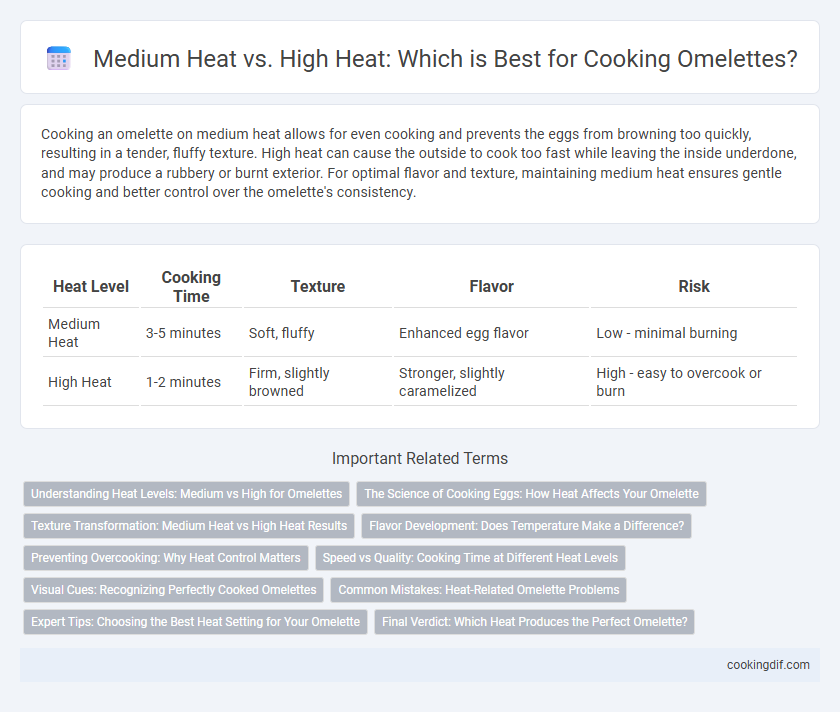Cooking an omelette on medium heat allows for even cooking and prevents the eggs from browning too quickly, resulting in a tender, fluffy texture. High heat can cause the outside to cook too fast while leaving the inside underdone, and may produce a rubbery or burnt exterior. For optimal flavor and texture, maintaining medium heat ensures gentle cooking and better control over the omelette's consistency.
Table of Comparison
| Heat Level | Cooking Time | Texture | Flavor | Risk |
|---|---|---|---|---|
| Medium Heat | 3-5 minutes | Soft, fluffy | Enhanced egg flavor | Low - minimal burning |
| High Heat | 1-2 minutes | Firm, slightly browned | Stronger, slightly caramelized | High - easy to overcook or burn |
Understanding Heat Levels: Medium vs High for Omelettes
Cooking an omelette at medium heat ensures even cooking and a tender texture by allowing the eggs to set slowly without burning. High heat often causes the outside to brown too quickly while leaving the inside undercooked, resulting in a less desirable texture. Mastering medium heat control is essential for achieving a perfectly fluffy and uniformly cooked omelette.
The Science of Cooking Eggs: How Heat Affects Your Omelette
Medium heat allows proteins in eggs to coagulate slowly, resulting in a tender, creamy omelette with evenly cooked curds, while high heat causes rapid coagulation that can make the eggs rubbery and dry. Precise heat control prevents overcooking by ensuring Maillard reactions are minimized, preserving the omelette's delicate texture and flavor. Understanding the thermal denaturation of ovalbumin and other egg proteins enables chefs to optimize the balance between texture and moisture retention in omelette preparation.
Texture Transformation: Medium Heat vs High Heat Results
Cooking an omelette on medium heat allows gradual protein coagulation, resulting in a soft, fluffy texture with creamy curds. High heat causes rapid protein denaturation and moisture evaporation, producing a firmer, drier omelette with a more rubbery texture. Controlling heat intensity directly influences the delicate balance between moisture retention and texture development in the finished dish.
Flavor Development: Does Temperature Make a Difference?
Cooking an omelette over medium heat allows proteins to cook evenly and promotes Maillard browning, enhancing flavor complexity and a tender texture. High heat risks burning the eggs quickly, resulting in a bitter taste and rubbery consistency due to uneven cooking. Temperature control is essential for optimal flavor development and the perfect balance of creamy and browned notes in an omelette.
Preventing Overcooking: Why Heat Control Matters
Cooking an omelette on medium heat ensures even cooking, preserving a tender, creamy texture while preventing browning or burning. High heat can cause the eggs to cook too quickly, leading to dryness and a rubbery consistency due to rapid protein coagulation. Precise heat control extends flavor complexity and prevents overcooking, crucial for achieving the optimal omelette quality.
Speed vs Quality: Cooking Time at Different Heat Levels
Cooking an omelette over medium heat allows for even heat distribution, resulting in a tender, creamy texture and preventing browning or burning. High heat significantly reduces cooking time but increases the risk of overcooked edges and unevenly cooked centers. Optimal omelette quality is typically achieved by balancing moderate heat with slight cooking speed adjustments to maintain moisture and softness.
Visual Cues: Recognizing Perfectly Cooked Omelettes
Cooking an omelette over medium heat allows for gradual setting, producing a uniformly pale yellow surface with slight browning at the edges, indicating tenderness and moisture inside. High heat results in rapid bubbling and dark brown spots, signaling overcooked or burnt areas that may taste bitter. Visual cues such as gentle puffiness and evenly opaque texture guide the cook to a perfectly cooked omelette when using medium heat.
Common Mistakes: Heat-Related Omelette Problems
Cooking an omelette on high heat often results in burnt edges and an undercooked center, a common heat-related mistake that compromises texture and flavor. Medium heat ensures even cooking by gently setting the eggs without rushing the process, preventing rubberiness and excessive browning. Maintaining medium heat is key to achieving a fluffy, tender omelette with a golden exterior and fully cooked interior.
Expert Tips: Choosing the Best Heat Setting for Your Omelette
Cooking an omelette on medium heat ensures even cooking and prevents browning too quickly, resulting in a soft, tender texture. High heat may cause the eggs to brown unevenly and develop a rubbery consistency, compromising flavor and appearance. Expert chefs recommend medium heat for control and better texture, enhancing the delicate balance of moisture and firmness in the perfect omelette.
Final Verdict: Which Heat Produces the Perfect Omelette?
Cooking an omelette on medium heat ensures even cooking, maintaining a tender and creamy texture while preventing browning or burning. High heat causes rapid cooking, leading to a rubbery texture and uneven doneness with potential burn spots. Medium heat is the ideal choice for producing the perfect, fluffy, and tender omelette.
Medium heat vs High heat for omelette cooking Infographic

 cookingdif.com
cookingdif.com